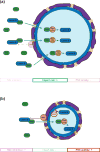Subcellular scaling: does size matter for cell division?
- PMID: 29501026
- PMCID: PMC5988940
- DOI: 10.1016/j.ceb.2018.02.009
Subcellular scaling: does size matter for cell division?
Abstract
Among different species or cell types, or during early embryonic cell divisions that occur in the absence of cell growth, the size of subcellular structures, including the nucleus, chromosomes, and mitotic spindle, scale with cell size. Maintaining correct subcellular scales is thought to be important for many cellular processes and, in particular, for mitosis. In this review, we provide an update on nuclear and chromosome scaling mechanisms and their significance in metazoans, with a focus on Caenorhabditis elegans, Xenopus and mammalian systems, for which a common role for the Ran (Ras-related nuclear protein)-dependent nuclear transport system has emerged.
Copyright © 2018 Elsevier Ltd. All rights reserved.
Figures



Similar articles
-
Mitotic chromosomes scale to nuclear-cytoplasmic ratio and cell size in Xenopus.Elife. 2023 Apr 25;12:e84360. doi: 10.7554/eLife.84360. Elife. 2023. PMID: 37096661 Free PMC article.
-
Mitotic chromosome length scales in response to both cell and nuclear size.J Cell Biol. 2015 Jun 8;209(5):645-51. doi: 10.1083/jcb.201502092. Epub 2015 Jun 1. J Cell Biol. 2015. PMID: 26033258 Free PMC article.
-
The GTPase Ran regulates chromosome positioning and nuclear envelope assembly in vivo.Curr Biol. 2002 Mar 19;12(6):503-7. doi: 10.1016/s0960-9822(02)00741-8. Curr Biol. 2002. PMID: 11909538
-
Organelle size scaling over embryonic development.Wiley Interdiscip Rev Dev Biol. 2020 Sep;9(5):e376. doi: 10.1002/wdev.376. Epub 2020 Jan 31. Wiley Interdiscip Rev Dev Biol. 2020. PMID: 32003549 Free PMC article. Review.
-
Size Scaling of Microtubule Assemblies in Early Xenopus Embryos.Cold Spring Harb Perspect Biol. 2015 Aug 10;7(10):a019182. doi: 10.1101/cshperspect.a019182. Cold Spring Harb Perspect Biol. 2015. PMID: 26261283 Free PMC article. Review.
Cited by
-
Mitotic chromosomes scale to nuclear-cytoplasmic ratio and cell size in Xenopus.Elife. 2023 Apr 25;12:e84360. doi: 10.7554/eLife.84360. Elife. 2023. PMID: 37096661 Free PMC article.
-
Unite to divide - how models and biological experimentation have come together to reveal mechanisms of cytokinesis.J Cell Sci. 2018 Dec 18;131(24):jcs203570. doi: 10.1242/jcs.203570. J Cell Sci. 2018. PMID: 30563924 Free PMC article. Review.
-
Volumetric morphometry reveals spindle width as the best predictor of mammalian spindle scaling.J Cell Biol. 2022 Jan 3;221(1):e202106170. doi: 10.1083/jcb.202106170. Epub 2021 Nov 17. J Cell Biol. 2022. PMID: 34787651 Free PMC article.
-
Cell Division: Tailoring a Swiftly Scaling Spindle.Curr Biol. 2019 Nov 4;29(21):R1135-R1137. doi: 10.1016/j.cub.2019.09.055. Curr Biol. 2019. PMID: 31689400 Free PMC article.
-
Emergent properties of mitotic chromosomes.Curr Opin Cell Biol. 2020 Jun;64:43-49. doi: 10.1016/j.ceb.2020.02.003. Epub 2020 Mar 6. Curr Opin Cell Biol. 2020. PMID: 32151949 Free PMC article. Review.
References
-
- Oh D, Yu C-H, Needleman DJ. Spatial organization of the Ran pathway by microtubules in mitosis. Proc Natl Acad Sci. 2016;113:8729–8734. Using modeling and by manipulating cultured cells, Oh et al. revealed that the interaction between SAFs and microtubules leads to a feedback mechanism that spatially amplifies spindle assembly factors to render spindle size independent of the RanGTP gradient. - PMC - PubMed
Publication types
MeSH terms
Grants and funding
LinkOut - more resources
Full Text Sources
Other Literature Sources
Miscellaneous

